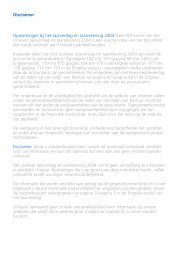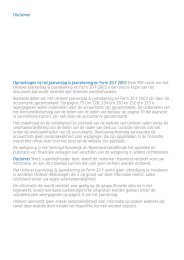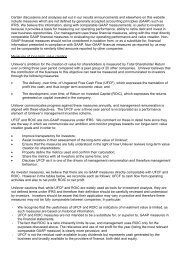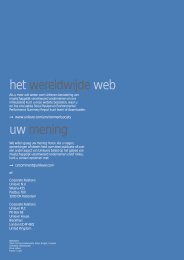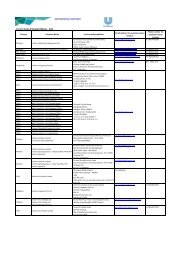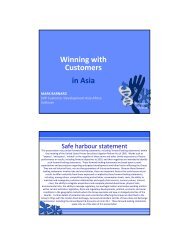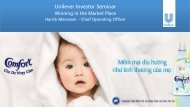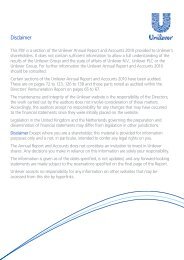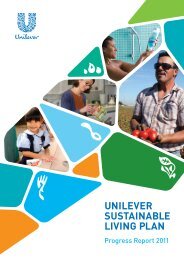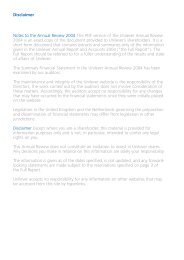Unilever Annual Report & Accounts and Form 20-F 2000
Unilever Annual Report & Accounts and Form 20-F 2000
Unilever Annual Report & Accounts and Form 20-F 2000
- TAGS
- unilever
- annual
- accounts-and-form
- f
You also want an ePaper? Increase the reach of your titles
YUMPU automatically turns print PDFs into web optimized ePapers that Google loves.
26<br />
<strong>Unilever</strong> <strong>Annual</strong> <strong>Report</strong> & <strong>Accounts</strong> <strong>and</strong> <strong>Form</strong> <strong>20</strong>-F <strong>20</strong>00<br />
Financial review<br />
Return on capital employed fell to 8% from 22% in 1999.<br />
The decline is due to the decrease in profit after tax,<br />
combined with the increase in long term borrowings.<br />
Results - 1999 over 1998<br />
Total turnover was 1.5% higher at €41 262 million.<br />
Group turnover increased 1.3% to €40 977 million.<br />
Underlying volume growth of 1% was partly offset by<br />
the slight strengthening of the euro against the basket<br />
of <strong>Unilever</strong> currencies.<br />
The Group’s share of joint venture turnover increased to<br />
€285 million from €<strong>20</strong>2 million in 1998.<br />
Group operating profit before exceptional items <strong>and</strong><br />
amortisation increased by 7%, reflecting a further<br />
strengthening in underlying margin of 0.5 percentage<br />
points of turnover to 11.1%.<br />
Amortisation of goodwill <strong>and</strong> intangibles rose to €23 million<br />
from €8 million in 1998.<br />
Exceptional charges of €269 million in 1999 compare with<br />
net gains in 1998 of €125 million which included the profit<br />
on the disposal of Plant Breeding International in the United<br />
Kingdom. The 1999 charge included €232 million for<br />
restructuring.<br />
Operating profit fell by 2% as a result of the above<br />
exceptional charges <strong>and</strong> amortisation of goodwill <strong>and</strong><br />
intangibles.<br />
Share of operating profit of joint ventures increased to<br />
€42 million (1998: €30 million) reflecting improved<br />
performance in our joint ventures in the United States<br />
<strong>and</strong> Portugal.<br />
Net interest costs were €14 million, compared with an<br />
interest income in 1998 of €156 million. The change was<br />
due to a €5.1 billion reduction in net funds during the year,<br />
following payment of €6.1 billion for the cash element of<br />
the special dividend in June 1999. Net interest cover for the<br />
year was more than 300 times, <strong>and</strong> over 30 times for the<br />
second half year. The net interest cover on the basis of<br />
EBITDA (bei) was 412 times in 1999.<br />
The Group’s effective tax rate reduced to 32% compared<br />
with 33% in 1998, mainly reflecting prior year tax credits.<br />
Minority interests increased to €<strong>20</strong>1 million (1998:<br />
€144 million) as a result of continued strong performance<br />
in India, <strong>and</strong> a return to profitability in Nigeria.<br />
Net profit fell by 6% as a result of the negative swing in<br />
exceptional items, <strong>and</strong> the impact on net interest of the<br />
special dividend. Combined earnings per share was<br />
unchanged at 39.48 euro cents per 1.4p of PLC ordinary<br />
capital <strong>and</strong> €2.63 per Fl. 1.12 of NV ordinary capital, as the<br />
<strong>Report</strong> of the Directors<br />
reduction in net income was offset by the reduction in<br />
the number of shares following the share consolidation.<br />
Combined earnings per share before exceptional items<br />
<strong>and</strong> amortisation rose by 9%.<br />
Return on capital employed increased to 22% from 16% in<br />
1998. This improvement is due to the more efficient capital<br />
structure resulting from the payment of the special dividend.<br />
The payment of the special dividend was responsible for a<br />
reduction of the Weighted Average Cost of Capital (WACC)<br />
of some 0.5%. WACC is calculated as the real cost of equity<br />
multiplied by the market capitalisation, plus the real after<br />
taxation interest cost of debt multiplied by the market value<br />
of the net debt, divided by the sum of the market values of<br />
debt <strong>and</strong> equity.<br />
<strong>20</strong>00<br />
Dividends <strong>and</strong> market capitalisation<br />
Ordinary dividends paid <strong>and</strong> proposed on PLC ordinary<br />
capital amount to 13.07p per 1.4p share (1999: 12.50p),<br />
an increase of 5% per share. Ordinary dividends paid <strong>and</strong><br />
proposed on the NV ordinary capital amount to €1.43 per<br />
Fl. 1.12 share (1999: €1.27), an increase of 13% per share.<br />
The ratio of dividends to profit attributable to ordinary<br />
shareholders increased to 133.3% (1999: 45.2%).<br />
<strong>Unilever</strong>’s combined market capitalisation at 31 December<br />
<strong>20</strong>00 was €65.3 billion (1999: €52.7 billion).<br />
Balance sheet<br />
The euro weakened slightly against the basket of <strong>Unilever</strong><br />
currencies between the two balance sheet dates. The<br />
resulting exchange gain on the translation of opening<br />
balances was offset by the exchange loss on the movement<br />
resulting from the equity injection into the US. Profit<br />
retained, after accounting for dividends <strong>and</strong> currency<br />
retranslation of opening balances <strong>and</strong> of movements,<br />
increased by €603 million to €7 146 million; the goodwill<br />
adjustment on disposal of Elizabeth Arden, included in the<br />
result for the year, was a writeback from reserves. Thus<br />
there was no net impact on profit retained.<br />
Total capital <strong>and</strong> reserves increased to €8 169 million (1999:<br />
€7 761 million) reflecting the above movements in retained<br />
profits less the value of shares purchased in respect of<br />
employee share option plans.<br />
Cash flow<br />
Cash flow from operations increased by €1 084 million to<br />
€6 738 million driven by the impact of acquistions <strong>and</strong> by<br />
an improvement in results before exceptional items <strong>and</strong><br />
amortisation together with further reductions in working<br />
capital, primarily in stocks. This was partially offset by cash<br />
flows in relation to exceptional charges <strong>and</strong> a €550 million<br />
payment to settle share options <strong>and</strong> similar obligations in<br />
Bestfoods consequent to the change of control.



